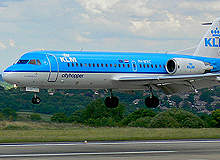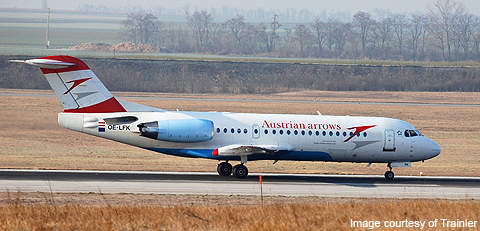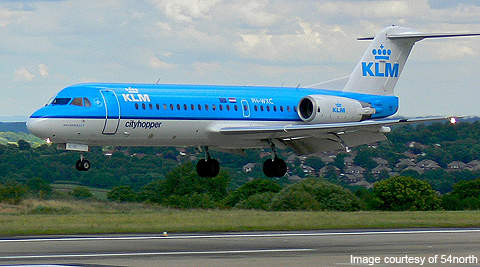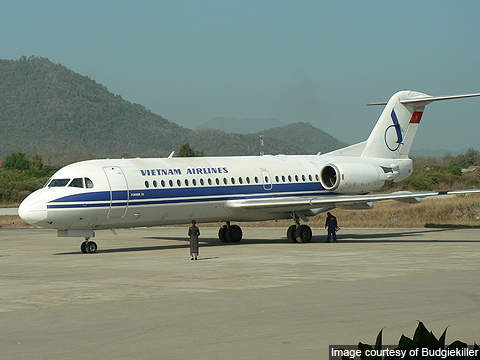A twin passenger airliner, the F70 was designed and built by Fokker Aircraft Company (FAC) of Netherlands. It was derived from the Fokker F100 aircraft. A total of 48 F70s were operational with 15 operators worldwide as of November 2009.
An advance version, the F70A was developed for deployment in the US. The Fokker F70ER is an extended range model introduced in 1994. It is fitted with an additional fuel tank to execute long range missions.
Orders and deliveries
The Fokker F70 orders received from various customers include: Austrian arrows (nine), KLM Cityhopper (six), Carpatair (three), Vietnam Airlines (two), Dutch Government (one), Casa Air Service (one), Ford Motor Company (two), Republic of Kenya (one), Republic of the Philippines (one), Sempati Air, Silkair (two) and so on.
America West Express acquired two Fokker F70s in 1995.
Design and features
The design of the F70 was 95% similar to that of the Fokker F100. The F70 was designed to meet the rigorous Federal Aviation Administration Stage 3 noise regulations. The exterior design of the aircraft comprises three liveries or two liveries with centre tank. The aircraft is equipped with cabin pressurisation system and air conditioning system.
Other features include electrical systems, hydraulic system, anti-icing system, taxi and landing lights, cargo doors, emergency door, rudder, ailerons, auxiliary power unit and landing gear. A speed brake, parking brake, thrust rating panel, printer, flap selector, elevator trim, fire panels and fuel panels are also installed in the aircraft.
Development
The development of the first F70 prototype began in November 1992 to supersede the Fokker F28 jetliner.
The prototype took off for its maiden flight in April 1993 from Woensdrecht base in southern Netherlands.
The first F70 production aircraft completed maiden flight in July 1994 and entered service with Ford Motor Company in October 1994.
It was built by decreasing the length of the Fokker 100 fuselage section by 4.62m and removing two emergency exits. The bankruptcy of FAC resulted in the halting of F70 production in 1996. Delivery of the last F70 took place in April 1997.
Flight deck
The Fokker F70 features a glass cockpit to accommodate a pilot and a copilot. The flight deck is equipped with primary flight display (PFD), multifunctional display (MFD), navigational display, automatic flight control system (AFCS) and dual flight management system (FMS).
It also houses a cockpit voice recorder (CVR), instrument landing system (ILS) receiver, electronic flight instrumentation system (EFIS), throttles, inertial reference system (IRS), radio magnetic indicator (RMI) and aircraft communication addressing and reporting system (ACARS). A required navigation performance (RNP 0.3) is also integrated to optimise the aircraft to fly in shorter routes.
Cabin
The spacious cabin of the F70 measures approximately 2.9m-wide and 2m-high, and can seat 80 passengers in five abreast seating configuration. The cabin area is divided in to business class and economy class with enough leg space for passengers onboard.
A downward opening main entrance door of 1.92m-long and 0.86m-wide along with integral stairs facilitate maximum operational flexibility. The cabin is equipped with LEDs, onboard oxygen generating systems (OBOGS) and ventilators.
Engines
The Fokker F70 is powered by two Rolls-Royce Tay 620-15 turbofan engines which produce 61.6kN of thrust each. The engines are fitted at the aft fuselage section.
The Tay 620-15 is a two-shaft high bypass ratio engine equipped with high pressure compressor, low pressure turbines, high pressure turbines and annular combustion system. The length and fan tip diameter of the engine are 28.6m and 13.4m respectively. The dry weight is 1,422kg.
Performance
The F70 can fly at a maximum speed of 856km/h. Its cruise speed is 800km/h. The stall speed is 222km/h. The range and service ceiling of the aircraft are 2,010km and 10,668m respectively.







